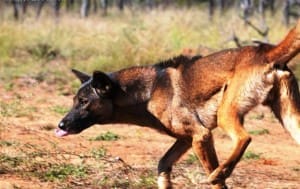 AgForce Cattle Board President Will Wilson said wild dogs were effecting the cattle industry right across Queensland in varying degrees through impacts such as mortality or through less obvious means like harassment and bites.
AgForce Cattle Board President Will Wilson said wild dogs were effecting the cattle industry right across Queensland in varying degrees through impacts such as mortality or through less obvious means like harassment and bites.
“Recently we had a case in Rockhampton where a pack of seven wild dogs killed two weaner bulls, a cow, and a large calf,” Mr Wilson said.
“When pack size is large like this, they are more than capable of taking down large stock and causing untold harm and destruction, not only to livestock but to domestic pets, especially in peri-urban areas of Queensland.
“There is also a real need for state forests and national parks to be controlled as they certainly are harbouring them.
“Ongoing, regular best practice management can help reduce the impacts by keeping dog numbers low, but it’s important producers keep an eye out for signs of dog activity and monitor the behaviour of stock that may be stressed due to dog activity and harassment.
“Control at key times during the year can be more effective in picking up young juvenile dogs or travelling males looking for mating partners as well.
“It’s important that any control programs are carried out in a coordinated way, with as many neighbouring properties as possible involved. The broader the scale of the program, the more effective it will be in the long run.”
AgForce’s Wild Dog Coordinators project has been helping reduce the threat posed by wild dogs via a successful collaboration between State and Local Government and industry.
The Queensland Feral Pest Initiative program has delivered 2,652 kilometres of exclusion fencing, protecting 1.59 million hectares of land from the predations of wild dogs.
AgForce Biosecurity Committee Chair Ivan Naggs said that when used in conjunction with other control measures like baiting and trapping, exclusion fencing was a very effective solution.
“Each year wild dogs kill or maim millions of dollars’ worth of livestock and exclusion fencing is helping reduce that,” Mr Naggs said.
“But we also need experienced people to help educate landholders in all aspects of control and the tools available, and to assist local councils develop legacy leaving management plans and coordinated programs to help control wild dogs. That’s where our Wild Dog Coordinators project has been vital.
“It’s important we continue to raise awareness about wild dogs roaming landscapes and how to control them.
“It’s about using every control tool available to reduce their numbers within the environment, reduce their impact on livestock, and allow our farming families to sleep easy at night.”
Source: AgForce. For assistance with wild dog control and information on best practice management techniques, producers should contact their local council, Rural Lands Officer, or AgForce.

How can I contact Gordon Gee tohelp erradicate wild dogs.Both Yeppoon and Rocky councils have no knowledge
Unfortunately one major problem with control methods is the rather blase approach to 1080 by some landowners. Not bothering to tell neighbours, not bothering to put up the warning signs and throwing them out willy nilly. Also how often to wild dogs get the blame for poor property management. I had one person blaming wild dogs when the culprit was bottle teated cows.